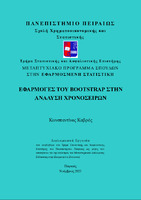Εφαρμογές του Bootstrap στην ανάλυση χρονοσειρών
Bootstrap applications to time series analysis

Προβολή/
Λέξεις κλειδιά
Bootstrap (Statistics) ; ΧρονοσειρέςΠερίληψη
Το bootstrap Efron (1979) είναι μια υπολογιστική στατιστική τεχνική η οποία έχει αποδειχθεί
ένα ισχυρό εργαλείο για την εκτίμηση της διακύμανσης αλλά και της δειγματικής κατανομής
μιας στατιστικής συνάρτησης είτε παραμετρικά είτε μη παραμετρικά. Αν και το bootstrap
αρχικά αναπτύχθηκε για ανεξάρτητα δεδομένα, στη συνέχεια επεκτάθηκε και για πιο σύνθετα
προβλήματα όπου τα δεδομένα είναι εξαρτημένα, όπως συμβαίνει στην περίπτωση των
χρονοσειρών. Στην παρούσα εργασία θα παρουσιαστούν οι κυριότερες τεχνικές bootstrap για
χρονοσειρές και θα εφαρμοστούν σε προσομοιωμένα αλλά και πραγματικά δεδομένα. Για
δεδομένα χρονοσειρών υπάρχουν δύο μέθοδοι εφαρμογής bootstrap. Η πρώτη είναι η
παραμετρική προσέγγιση όπου υποτίθεται ότι τα δεδομένα προέρχονται από κάποιο
παραμετρικό μοντέλο και το bootstrap γίνεται στα κατάλοιπα που προκύπτουν μετά από την
εκτίμησή του. Η δεύτερη προσέγγιση είναι η μη παραμετρική, δηλαδή ελεύθερη μοντέλου,
όπου η δειγματοληψία με επανάθεση πραγματοποιείται σε blocks παρατηρήσεων της αρχικής
χρονοσειράς.
Η παρούσα διπλωματική εργασία αποτελείται από πέντε κεφάλαια. Στα πρώτα τρία κεφάλαια
παρουσιάζεται το θεωρητικό υπόβαθρο του αντικειμένου της διπλωματικής εργασίας ενώ στα
υπόλοιπα πραγματοποιείται εφαρμογή των μεθόδων. Πιο συγκεκριμένα, στο πρώτο κεφάλαιο
παρουσιάζεται η κλασική μέθοδος bootstrap και κάποιες παραλλαγές της που αναφέρονται στο
κύριο μέρος της εργασίας. Στο δεύτερο κεφάλαιο γίνεται μια εισαγωγή στις χρονοσειρές και
σε μοντέλα που θα χρησιμοποιηθούν στο bootstrap χρονοσειρών. Το τρίτο κεφάλαιο αποτελεί
το κύριο μέρος της εργασίας στο οποίο παρουσιάζονται θεωρητικά οι μέθοδοι bootstrap για
χρονοσειρές. Στην συνέχεια στο τέταρτο κεφάλαιο γίνεται οπτικοποίηση των αποτελεσμάτων
της εφαρμογής των μεθόδων και μια μελέτη προσομοίωσης ώστε να φανεί η συμπεριφορά των
μεθόδων bootstrap σε μια αυτοπαλίνδρομη διαδικασία πρώτης τάξεως. Τέλος, στο πέμπτο
κεφάλαιο πραγματοποιείται εφαρμογή των μεθόδων σε ένα πραγματικό σύνολο δεδομένων.
Για τη μελέτη προσομοίωσης και την ανάλυση των δεδομένων έχει χρησιμοποιηθεί η γλώσσα
προγραμματισμού R.


